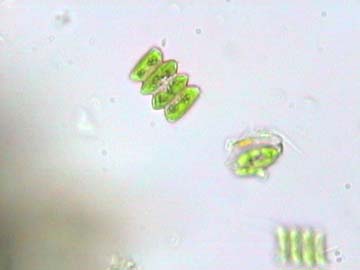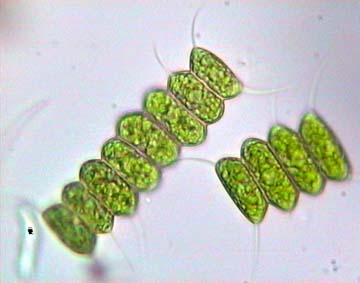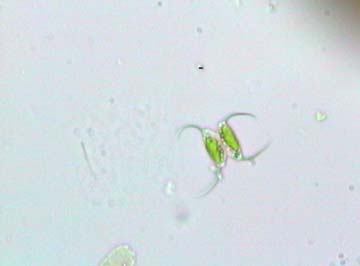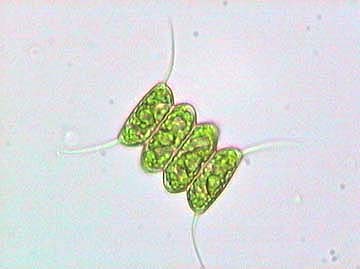

Images
of desmids from the genus Scenedesmus
by Mike
Morgan, UK
Some spun down silt from the bottom of a pond showed a number of species of Scenedesmus.
Scenedesmus: This is a member of the Phylum Chlorophyta, in the Order Chlorococcales and Family Scendesmaceae It occurs as flat colonies of 2, 4 or 8 cells arranged in a row, though there may be a single row of 12 cells. The cells are oval, fusiform, or crescent-shaped according to the species. In some there are 2 forms of cells in the same colony (coenobe), the individuals at the outside of the row often being lunate, rather than oval, and different in the form of spines Most species have spines at the corners of the colonies. Each cell has a parietal plate-like chloroplast and usually one pyrenoid (a protein granule and site of starch formation). The cells are 5-30 m m long. The normal method of reproduction is asexual by autocoenobium. There are numerous species and varieties of this genus; perhaps the most common species is S. quadricauda. Growth is large in nutrient rich waters.
Comments to the
author
Mike
Morgan
are welcomed.


Left: Scenedesmus incrassatulus. Right: Scenedesmus opoliensis.


Left: Scenedesmus obliquus. Right: Scenedesmus quadricauda.
Published in the October 2005 edition of Micscape.
Please report any Web problems or offer general comments to the Micscape Editor .
Micscape is the on-line monthly magazine of the Microscopy UK web site at Microscopy-UK
© Onview.net Ltd, Microscopy-UK, and all contributors 1995
onwards. All rights reserved.
Main site is
at www.microscopy-uk.org.uk
with full mirror
at www.microscopy-uk.net
.